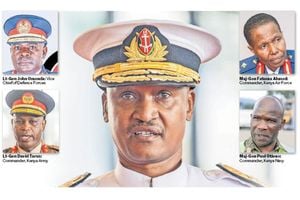Badges worth a thousand words

FILE | NATION
For civilians, it may be hard to spot the difference when President Mwai Kibaki congratulated the incoming Chief of Defence Forces Gen J. W. Karangi, left, and an earlier Lt-Gen Karangi.
After Julius Waweru Karangi was named Chief of Defence Forces, he did not only assume the General’s title, he donned new uniform.
It’s not conspicuous to the ordinary person, but badges that adorn his uniform are unique, evoking respect and pride among those who wear the military gear.
Usually worn on caps, collars, lapel, sleeve and shoulders, military badges and insignia connote the level of leadership, responsibility for personnel, equipment as well as the mission bestowed upon an officer.
When Gen Karangi appeared at State House after appointment, a close look reveals an addition to the badges of rank on his shoulder board.
Previously as Lieutenant general, he wore what appear to be a crossed sword and a baton, plus another resembling a court of arms referred to as the crest in military circles.
Full General
The pip, a diamond shaped design was added on the shoulder board upon promotion, showing he is the only full General in Kenya and no other military officer can wear a combination of the three symbols.
Being the military chief, he is a four-star general, which is also displayed on the collar.
Known in the Forces as a gogdet, the red fitting on the collar is decorated with four stars, showing the officer is the General.
Lieutenant-generals, major-generals, and brigadiers, who are senior officers in that order, wear three, two and one star respectively.
However, while stars are clearly visible on the Army uniform, it’s presented in a different pattern the air force uniform.
Gen Kariangi’s background is the Air Force and he has to wear the unit’s during the years he is in service. Corresponding stars are also fixed on the General’s official transport, and he is provided with escort cars and bodyguards drawn from the military police.
Military police are drawn from all formations – Navy, Army and Air force – but are easily identified with their blight red berets.
The Chief of Defence Forces also flies a flag on the official car, usually a limousine, without the ordinary GK registration number plates.
In it’s place the number plate is inscribed with initials CGS (Chief of the General Staff), as was the case with former military boss Jeremiah Kianga.
The title has since been renamed Chief of the Defence Forces.
Other senior military officers with flags on the vehicles are Army commander John Kasaon, Navy commander Ngewa Mukala and Air Force commander Joff Otieno.
Other parts of the military gear are worn across all ranks irrespective of ranks.
The court of arms on Gen Karangi’s cap denotes his work station, the Defence headquarters in Nairobi and is displayed by all officers deployed there.
His cap is also decorated with golden markings, a feature only a preserve of senior officers.
When in public Gen Karangi may appear in different attires including the Air Force camouflage uniform or the blue official uniform.
The badges of ranks are supposed to be recognised by every officer so that he or she salutes when meeting a colleague of higher rank.
Display ranks
Juniors, who are the soldiers, display their ranks by wearing chevrons on the sleeves.
During national celebrations, the General is resplendent in full ceremonial uniform, including decorations awarded by the President.
Such decorations, presented as medals are usually displayed on the breast.
On such occasions he also wears an aiguillette, a golden decorative cord worn on the shoulders.
A look at the officers lapel, one can tell the years he or she has served as well as the Presidents who have ruled during the years of service.
Another preserve of the military boss is a ride with the President atop an open Land Rover when he arrives at the stadium for national holidays.
Inspecting the half guard, a parade mounted by soldiers in his honour is also preserved for the CDF, including when visiting foreign countries.




